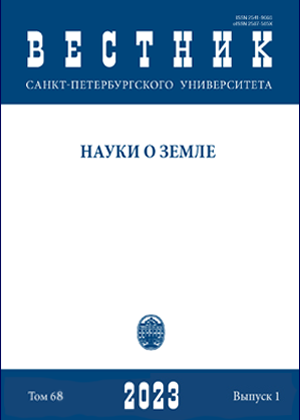Hydrochemical assessment of transboundary rivers (on the example of the Narva border river)
DOI:
https://doi.org/10.21638/spbu07.2023.108Abstract
The purpose of the study is to establish the regularities of the formation of the biogenic regime of the Narva River. Based on experimental data on the determination of concentrations of chemical elements for the long-term observation period from 1992 to 2019, a trend of reducing the content of biogenic elements over the past 14 years has been revealed. This is a consequence of reducing the anthropogenic load due to the reconstruction of treatment facilities on the Estonian and Russian sides. Analysis of intra-annual changes in the content of biogenic elements showed a steady increase in the content of nitrogen compounds during high water with maximum water runoff and an increase in phosphorus content in the autumn period. This indicates a significant influence of the waters of Lake Peipus and the Narva reservoir, which determine the intra-reservoir processes that intensify at the end of the warm season. The calculation of runoff based on experimental data of average annual water consumption and monthly determinations of concentrations of mineral, biogenic and organic substances for the period from 1992 to 2019. The calculated values of the runoff indicators are: ionic runoff 43,1 t/km2, total phosphorus 9,8 kg/km2, total nitrogen 142 kg/km2, organic carbon 2,75 t/km2, according to the background values of the runoff indicators of the Baltic region. It is important to note that for the period from 1993 to 2006; significantly higher runoff rates for phosphorus phosphates and nitrogen nitrates corresponded to the literature data on runoff from reclaimed agricultural areas, which also indicates a significant decrease in the biogenic load on the Narva River in the last decade from 2006 to 2019.
Keywords:
Runoff of dissolved substances, biogenic and organic substances, microelements
Downloads
References
Алекин, О. А. (1970). Основы гидрохимии. Ленинград: Гидрометеоиздат.
Алекин, О. А. (1974). Сток растворенных веществ. Ленинград: Гидрометеоиздат.
Брызгало, В. А. и Иванов, В. В. (2009). Сток растворенных веществ на замыкающих створах рек бассейнов Арктических морей России. Многолетняя и сезонная изменчивость. Экологическая химия, 2, 60-89.
Кондратьев, С. А., Брюханов, А. Ю. Игнатьева, Н. В., Шмакова, М. В., Обломкова, Н. С., Коробченкова, К. Д. (2021). Внешняя и внутренняя фосфорная нагрузка на крупный трансграничный водоем в условиях минимальной проточности. Фундаментальная и прикладная гидрофизика, 14 (4), 65-86.
Мальцева, А. В., Тарасов, М. Н., Смирнов, М. П. (1987). Сток органических веществ с территории СССР. Гидрохимические материалы, 102, 54-67.
Минаев, В. А. (1967). Вынос солей из почв осушаемого болота. Почвоведение, 10, 35-47.
Назаров, Г. В. (1988). Антропогенная перестройка выноса фосфора в водные объекты в процессе развития земледелия. В: Эволюция круговорота фосфора в эвтрофировании природных вод. Ленинград: Наука, 44-66.
Найденова, В. И. (1971). Гидрохимическая характеристика средних и больших рек европейской части СССР. Ленинград: Гидрометеоиздат.
Никаноров, А. М. (2001). Гидрохимия. СПб.: Гидрометеоиздат.
Никаноров, А. М. (2011). Региональная гидрохимия. Ростов-на-Дону: НОК.
Ресурсы поверхностных вод. Карелия и Северо-Запад (1970). Ленинград: Гидрометеоиздат.
Схема комплексного использования и охраны водных объектов бассейна реки Нарва (2014). [online] Невско-ладожское бассейновое водное управление федерального агентства водных ресурсов. Доступно на: http://www.nord-west-water.ru/activities/ndv/scheme-of-complex-use-and-protection-of-water-bodies-in-the-basin-of-the-narva-river-approved-documents/ [Дата доступа 23.11.2015].
Тимм, Т., Раукас, А., Хаберман, Ю., Яани, А., под ред. (2012). Псковско-Чудское озеро. Тарту: Eesti Loodusfoto.
Фрумин, Б. С. и Фетисова, Ю. А. (2017). Динамика качества вод трансграничной реки Нарва. Общество. Среда. Развитие, 1, 85-87.
Юхно, А. В. и Задонская, О. В. (2020). Оценка состояния речной экосистемы и антропогенного воздействия на нее с применением модальных интервалов (на примере р. Нарва). В: Сборник докладов международной научной конференции Четвертые Виноградовские чтения, 855-860.
CCME Water (2017). Canadian Water Quality Guidelines for the Protection of Aquatic Life: Water quality index user’s manual. [online] Canadian Council of Ministers of Environment. Доступно на: https://www.ccme.ca/en/resourcesCanadianEnvironmentalQualityGuidelines/ProtocolsandReference [Дата доступа 02.02.2018].
Hannerz, F., Langaas, S., Nilssonand, S., Yi. Tian (2002). A Multi-Thematic GIS Database of the Transboundary Narva River. In: Lake Peipsi catchment in support of strategic science and management applications. Eesti Loodusfoto, 68-65.
Jakob, A. (1997). Modelling Solute Transport Using the Double Porous Medium Approach. In: Modelling in aquatic chemistry. Paris, France, Organisation for economic cooperation and development. Nuclear Energy Agency, 525-576.
Roll, G., Kosk, A., Alexeeva, N., Unt, P. (2003). Lake Peipsi-Chudskoe. In: Lake Basin Management Initiative Regional Workshop for Europe, Central Asia and the America. USA, Vermont, 18-21 June.
Downloads
Published
How to Cite
Issue
Section
License
Articles of "Vestnik of Saint Petersburg University. Earth Sciences" are open access distributed under the terms of the License Agreement with Saint Petersburg State University, which permits to the authors unrestricted distribution and self-archiving free of charge.






